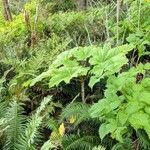Shrub 1–3 m, densely prickly on the stem, petioles, and lf-veins; lvs long-petioled, subrotund, 5–7-lobed, to 3.5 dm, cordate at base, the lobes acuminate or cuspidate, serrate; 2n=48. Wet woods; Isle Royale, Mich. and adj. n. Ont.; Oreg. to Mont., n. to Alas., and in e. Asia. June. The Amer. plants are var. horridus. (Fatsia h.; Echinopanax h.)






